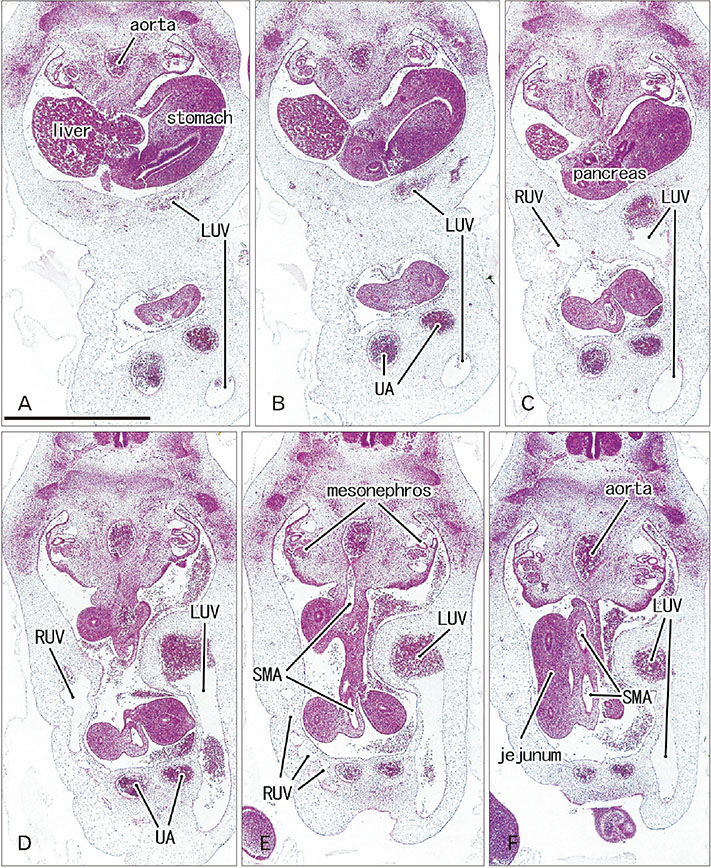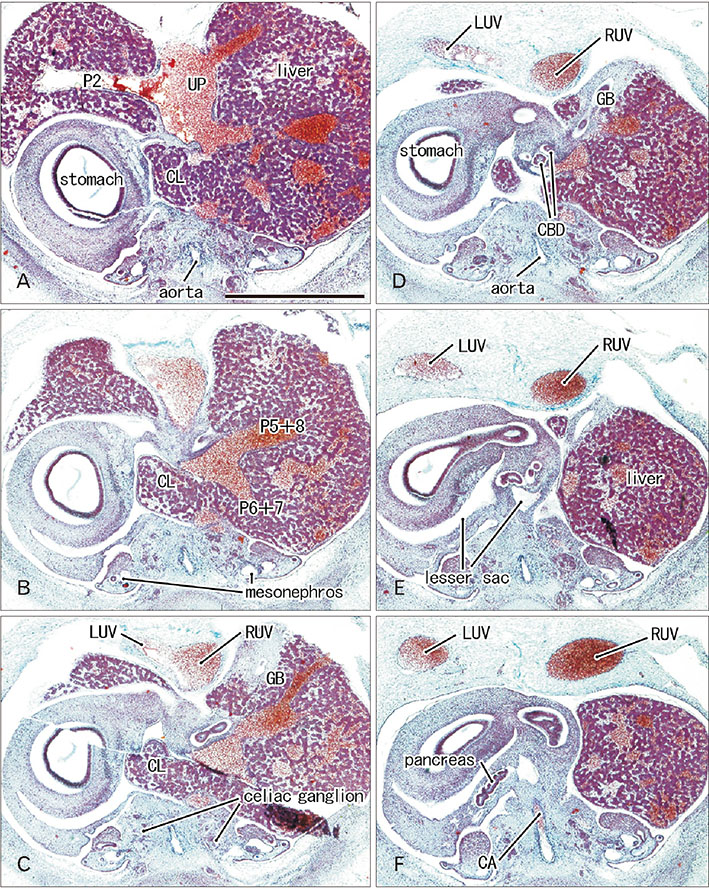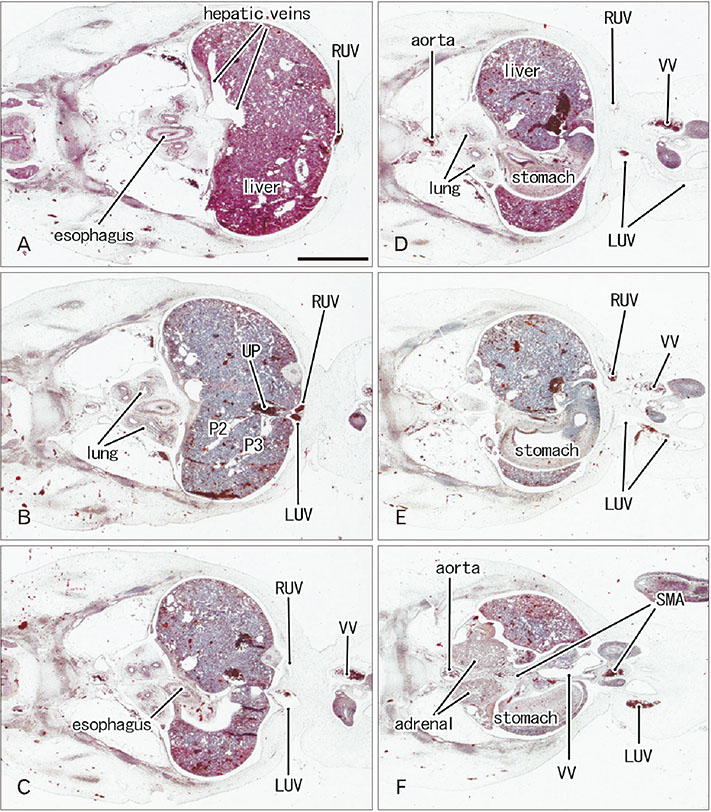Anat Cell Biol.
2018 Sep;51(3):218-222. 10.5115/acb.2018.51.3.218.
Persistent right umbilical vein: a study using serial sections of human embryos and fetuses
- Affiliations
-
- 1Department of Anatomy and Institute of Medical Sciences, Chonbuk National University Medical School, Jeonju, Korea. 407kk@hanmail.net, okchai1004@jbnu.ac.kr
- 2Department of Anatomy, Wuxi Medical School, Jiangnan University, Wuxi, China.
- 3Division of Internal Medicine, Sapporo Asuka Hospital, Sapporo, Japan.
- 4Department of Anatomy and Human Embryology, Institute of Embryology, Faculty of Medicine, Complutense University, Madrid, Spain.
- KMID: 2447018
- DOI: http://doi.org/10.5115/acb.2018.51.3.218
Abstract
- Persistent right umbilical vein (PRUV) is a common anomaly of the venous system. Although candidates for future PRUV were expected to occur more frequently in earlier specimens, evaluation of serial horizontal sections from 58 embryos and fetuses of gestational age 5-7 weeks found that only two of these embryos and fetuses were candidates for anomalies. In a specimen, a degenerating right umbilical vein (UV) joined the thick left UV in a narrow peritoneal space between the liver and abdominal cavity, and in the other specimen, a degenerating left UV joined a thick right UV in the abdominal wall near the liver. In these two specimens, the UV drained into the normal, umbilical portion of the left liver. These results strongly suggested that, other than the usual PRUV draining into the right liver, another type of PRUV was likely to consist of the right UV draining into the left liver.
Keyword
MeSH Terms
Figure
Cited by 1 articles
-
Topographical relationships of the yolk sac remnant and vitelline vessels with the midgut loop in the extra-embryonic coelom of human embryos
Zhe-Wu Jin, Ji Hyun Kim, Masahito Yamamoto, Gen Murakami, Shin-ichi Abe, José Francisco Rodríguez-Vázquez
Anat Cell Biol. 2022;55(3):356-366. doi: 10.5115/acb.22.054.
Reference
-
1. Canavan TP, Hill LM. Neonatal outcomes in fetuses with a persistent intrahepatic right umbilical vein. J Ultrasound Med. 2016; 35:2237–2241.
Article2. Kirsch CF, Feldstein VA, Goldstein RB, Filly RA. Persistent intrahepatic right umbilical vein: a prenatal sonographic series without significant anomalies. J Ultrasound Med. 1996; 15:371–374.
Article3. Yagel S, Cohen SM, Valsky DV, Shen O, Lipschuetz M, Messing B. Systematic examination of the fetal abdominal precordial veins: a cohort study. Ultrasound Obstet Gynecol. 2015; 45:578–583.
Article4. Shindoh J, Akahane M, Satou S, Aoki T, Beck Y, Hasegawa K, Sugawara Y, Ohtomo K, Kokudo N. Vascular architecture in anomalous right-sided ligamentum teres: three-dimensional analyses in 35 patients. HPB (Oxford). 2012; 14:32–41.
Article5. Ricklan DE, Collett TA, Lyness SK. Umbilical vein variations: review of the literature and a case report of a persistent right umbilical vein. Teratology. 1988; 37:95–100.
Article6. Gupta R, Miyazaki A, Cho A, Ryu M. Portal vein branching pattern in anomalous right-sided round ligament. Abdom Imaging. 2010; 35:332–336.
Article7. Kawai K, Koizumi M, Honma S, Tokiyoshi A, Kodama K. Right ligamentum teres joining to the right branch of the portal vein. Anat Sci Int. 2008; 83:49–54.
Article8. Martin BF, Tudor RG. The umbilical and paraumbilical veins of man. J Anat. 1980; 130(Pt 2):305–322.9. Lin G, Lunderquist A, Hägerstrand I. Umbilical and paraumbilical veins in ligamentum teres. Their significance as collaterals in portal hypertension. Acta Radiol Diagn (Stockh). 1984; 25:1–5.10. Ibukuro K, Tanaka R, Fukuda H, Abe S, Tobe K. The superior group of vessels in the falciform ligament: anatomical and radiological correlation. Surg Radiol Anat. 2008; 30:311–315.
Article
- Full Text Links
- Actions
-
Cited
- CITED
-
- Close
- Share
- Similar articles
-
- Umbilical cord vessels other than the umbilical arteries and vein: a histological study of midterm human fetuses
- A marginal branch of the left hepatic artery running along the umbilical vein and supplying the anterior surface of the liver left lobe: a report of 5 cases in 12 Japanese human fetuses
- Classification of Umbilical Vein Anomalies Based upon Cases in Dead Fetuses
- Embryogensis of Human Liver
- An anomalous portal vein crossing the lesser sac and ending at the upper part of ductus venosus




